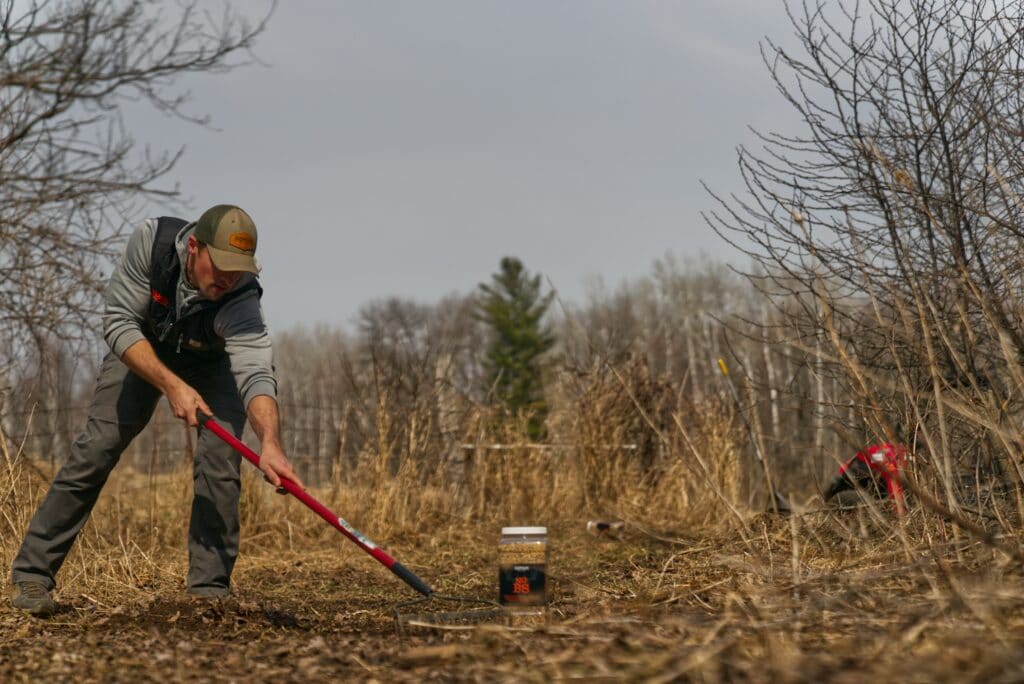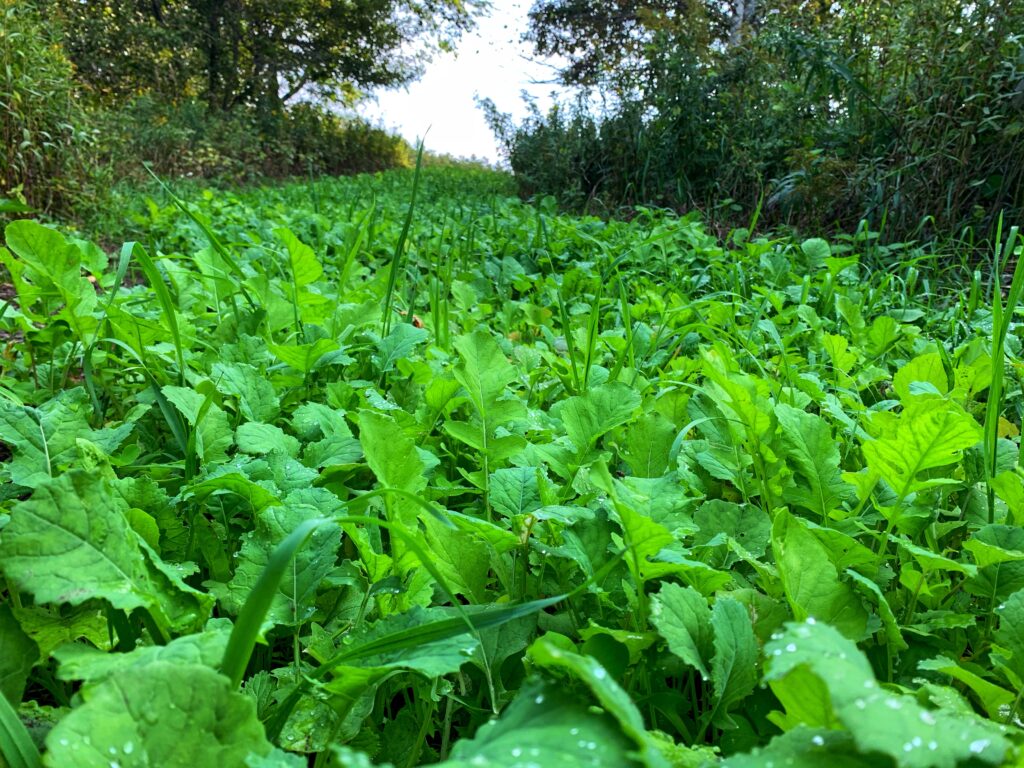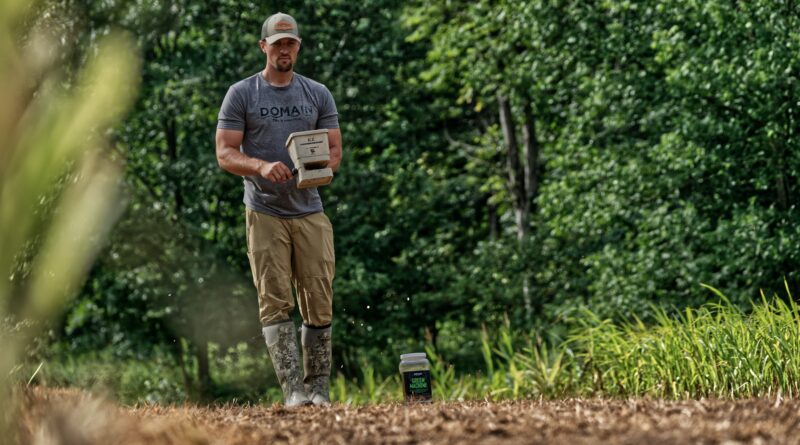5 Tips for an Ideal No-Till Food Plot
Just because you don’t have a tractor or farm equipment doesn’t mean planting a food plot is out of reach. If you have the right seed mix, a little help from Mother Nature, some standard garden tools, and a little ambition, you can create your very own secluded, backwoods, no-till deer food plot. There are a few important steps you’ll need to follow and then it’s time to get to work. Fair warning no-till food plots are not easy. They can lead to blistered hands, soiled shirts, and the need for a few cold beers! Read on for my proven tips for your own no-till food plot.
Selecting a No-Till Deer Food Plot Location
First, you want to look for an area that is well-drained and offers sunlight to the forest floor for at least 50% of the day. Many no-till food plot locations are backwoods, micro hunt plots with minimal sunlight and that’s ok, there are mixes that can thrive in those conditions.
If you’re creating an opening for a no-till food plot location, select an area that you can easily access without bumping deer from their bedding area. Try to focus on access routes that are between key bedding areas and destination food sources. Also, it’s a good idea to pick a location that offers optimal hunting opportunities with your prevailing wind direction. Finally, if the area you select is too shaded, you can always create more sunlight with a little strategic “lumber-jack” work.
Test your Soil PH Level
Testing your pH level is quite possibly the most important step to planting a successful food plot. This is true for both till and no-till food plots.
You have a couple of options to test your soil pH. First, you can use Domain’s DIY Instant pH Soil Test Kit. This will give you feedback on your soil pH in less than 20 minutes. The Test Kit will also provide insight on the amount of lime to apply, based on your current pH level. Remember a pH of 7.0 is your ultimate goal.
Your other option is to take a soil test to your local co-op and get a comprehensive test. These tests can take weeks or months but will provide a complete analysis of the nutrients, organic matter, and pH level of your soil.
Once you have an accurate reading of your soil’s pH you may or may not need to apply Lime. Lime helps increase your pH level. When you don’t have access to equipment, I recommend using pelleted lime, which you can typically buy in 40 lb bags at your local hardware store.

Preparing the Soil for your Food Plot
Removing Debris
Since you don’t have equipment to do the work for you, this is where you will earn your luck this deer season. For all of the no-till food plots I’ve planted (and I’ve done a lot of them) I typically will use a wide landscaping rake and a steel garden rake to remove debris and create a good soil environment.
Removing debris is a critical step to ensure good seed-to-soil contact when planting, take extra effort to ensure as much debris is cleared as possible. First, I will take the landscaping rake and rake away ALL leaves, sticks, and debris. This should leave dirt showing over the entire food plot.
AT THIS POINT YOU HAVE 2 OPTIONS:
1) LEAVE THE PLOT ALONE FOR A COUPLE OF WEEKS AND ALLOW WEEDS TO GERMINATE. AFTER THEY GERMINATE YOU CAN SPRAY ROUND UP TO ELIMINATE THEM AND THEN GO TO THE PLANTING STEPS BELOW
2) MOVE AHEAD TO THE PLANTING STEPS BELOW. YOUR NO-TILL FOOD PLOT MIX WILL GROW QUICKLY PROVIDED THE PH IS GOOD AND HELP OUT-COMPETE ANY WEEDS THAT MAY EXIST IN THE SOIL.
Applying Lime and Fertilizer
Once the debris is removed, I will apply lime (if needed) and fertilizer (recommended) to the area I will be planting. For Domain’s No BS Food Plot Mix, my preferred fertilizer would be a 19-19-19. If you’re planting Hot Chic then a 6-23-30 can be applied. Once the fertilizer is spread throughout the plot I will take the steel garden rake and with some effort, rough up the soil. Try to disturb the top 3-4” of soil. During this time you are creating the perfect seedbed and also working in the lime and fertilizer. (Fertilizer ratios can vary from supplier to supplier – please contact us if you have questions).
After you’ve worked up the soil (this will help the plants more easily establish their root system) I like to go back to the wider landscaping rake to even out and level the plot prior to seeding. Now that the food plot area is cleared of weeds and debris, you’ve taken steps to improve the soil, applied “plant food”, you are ready for seeding your plot. Before seeding, stop for a quick “hydration break”, with a cold one of your choosing! Planting food plots should be fun, right!?
Seeding your Deer Food Plot
Selecting the right seed
Domain’s No BS Food Plot Mix or Hot Chic Food Plot Mix are my preferred choices for true no-till food plots, where you have only hand tools, and the plot is semi-shaded. Both of these mixes include annuals and perennials. They will establish quickly, are shade tolerant, drought-tolerant, and can handle diverse growing conditions.
Planting your seed
While I’ve seen people simply throw the seed throughout their plot and have success, I prefer to use a hand seeder and evenly spread the seed throughout the food plot area. You should be able to visually see both mixes to ensure proper coverage as you walk the plot. No BS seed covers 11,000 square feet and Hot Chic seed can cover 22,000 square feet. While it can be difficult, try to stick to the recommended seed rate for each mix.
Covering the seed
Once you’ve evenly spread the seed throughout the plot, take the wide leaf rake and lightly rake over the seeds, this will help them from washing out with the first heavy rain and helps pack the soil since you don’t have the equipment to roll or cultipack.
Now that your plot is planted, it’s time to let Mother Nature do her thing. With appropriate sunshine and rain your food plot should begin to germinate within a week or two and start to grow the forages that your deer will seek out in the Summer, Fall, and Winter. Once your plot begins to mature, there are a few things that can be done to maintain it and keep it healthy.

Food Plot Maintentance
Food Plot Maintenance can occur in a variety of forms, but one of the best forms of maintenance for a perennial forage mix like Hot Chic is to provide it with a slight “haircut”. If the clovers begin to flower or the chicory becomes over-mature, I will use a weed whip and carefully trim the tops of the plants (and any weeds) to help generate re-growth. Typically following this ”haircut” deer will become even more attracted to the plot, because the fresh growth provides the highest level of protein.
Additionally, prior to an anticipated rainfall, you can add some additional fertilizer to help provide important nutrients to maximize forage production.
No-Till Food Plots – Final Thoughts
Now that you’ve dedicated the time and effort to plant your backwoods no-till food plot, it’s time to sit back, have a cold one, and celebrate your accomplishment. Now you can hang a trail cam or two, and wait for the season to start. These small micro plots can provide fantastic opportunities to catch deer feeding as they head to or from bedding or a major food source. They are also great spots to sit during the rut. Remember, just because you don’t have the equipment, doesn’t mean you can’t plant a food plot. A little sweat equity can go a long way!
Happy planting!!

By Mike Lindahl
Mike is the Co-Owner and Managing Partner of Domain Outdoor, a family-owned Deer Management Company. Mike is an avid hunter and outdoorsman with 10 years of experience in the outdoor industry and extensive background in product development, implementation, and marketing. If you have any questions regarding what to plant or how to plant no-till food plots please send Mike a note.
Note: HuntTested may receive a small commission if you purchase a product from the links on this page. This does NOT increase your price and helps to pay for the content you’re enjoying. All opinions belong to HuntTested.
Related Content: The Ultimate Whitetail Deer Gear List


